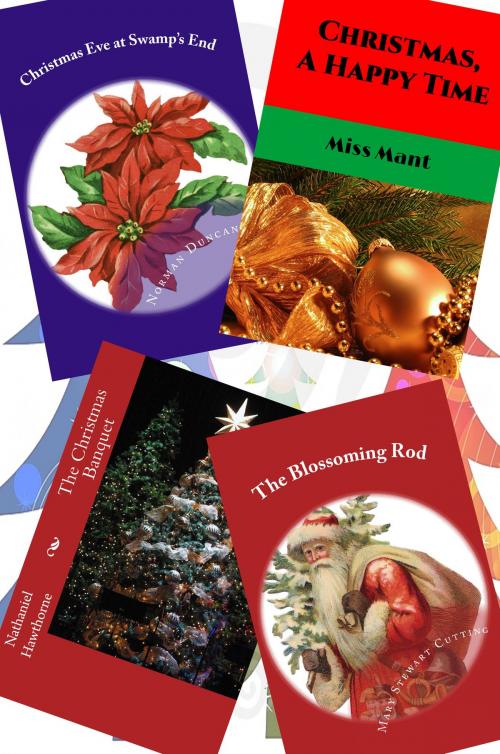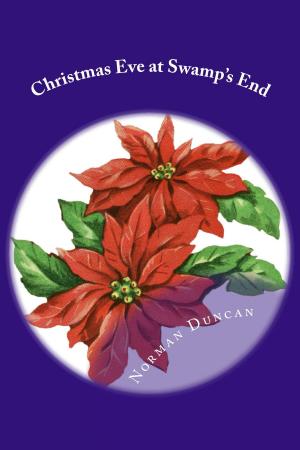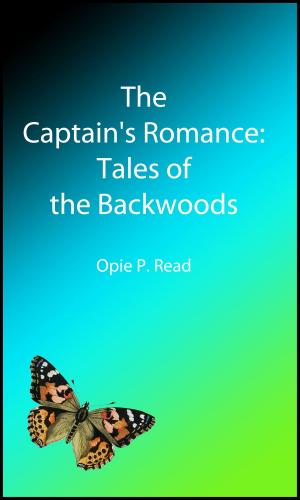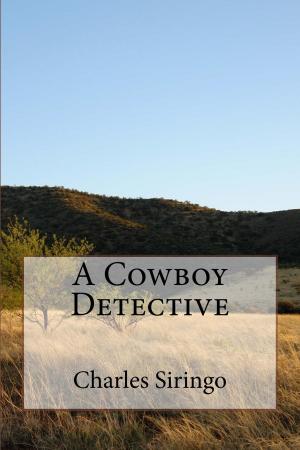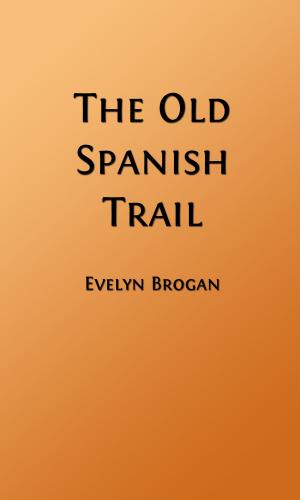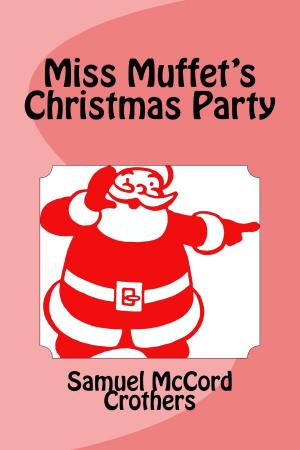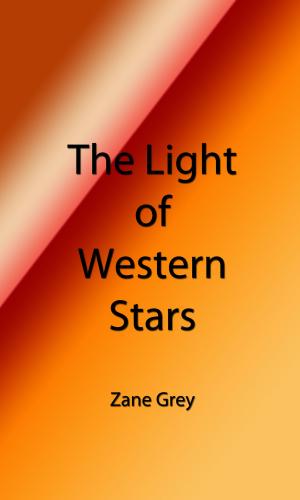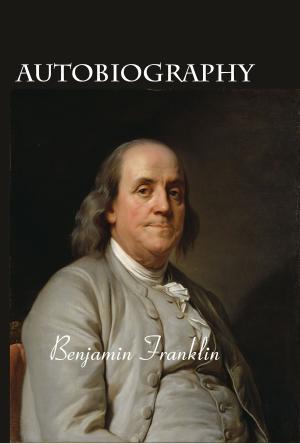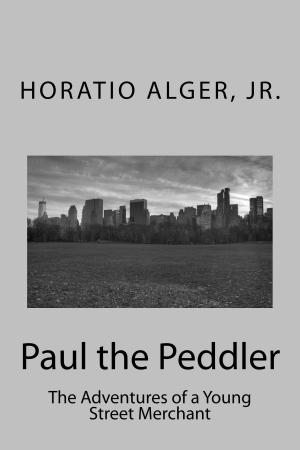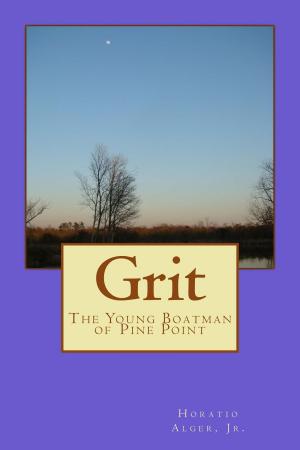| Author: | Norman Duncan, Alicia Catherine Mant ("Miss Mant"), Mary Stewart Doubleday Cutting, Nathaniel Hawthorne | ISBN: | 1230002831268 |
| Publisher: | Steve Gabany | Publication: | November 10, 2018 |
| Imprint: | Language: | English |
| Author: | Norman Duncan, Alicia Catherine Mant ("Miss Mant"), Mary Stewart Doubleday Cutting, Nathaniel Hawthorne |
| ISBN: | 1230002831268 |
| Publisher: | Steve Gabany |
| Publication: | November 10, 2018 |
| Imprint: | |
| Language: | English |
Four classic Christmas short stories from the pens of some of the best authors ever. Sure to delight readers young and old alike :
#1: Christmas Eve as Swamp's End
This is a short-story from a collection about life in the Northwest. A young woman desperately wants a baby. Unfortunately, she isn't married, and her prospects of finding a husband in this VERY small community aren't good. She cares for other's children whenever she can -- "adopts" them, at least in her mind. But it isn't the same; she wants a baby of her own.
Norman Duncan (2 July 1871 -8 October 1916) was an author, journalist and educator. Duncan was born in Brantford, Ontario, a son of Augustus and Susan (Hawley) Duncan. He was educated in the University of Toronto, graduating in 1895. From 1897 to 1901 Duncan was on the staff of The New York Evening Post. After 1900, he lived mainly in the United States. In 1902, Duncan was appointed professor of rhetoric at Washington and Jefferson College in Washington, Pennsylvania, a position he held until 1906, when he became adjunct professor of English literature at the University of Kansas.
Duncan made several trips to Newfoundland and Labrador, which he then used as a setting for some of his books, including Doctor Luke of the Labrador.
Duncan published over 20 books, including short stories, novels, and travel journalism.
--------------------
#2: Christmas, A Happy Time
This is a charming short story about two sisters who look forward to having their older brothers back home from school for Christmas. The setting is the countryside in Great Britain. As you read it to your children, remember that it was written in 1832, so, they may not be familiar with some of the words, and the writing style may seem a bit dated. Despite a sad moment when the family dog falls through thin ice and drowns, which is used as a lesson for the children to stay off the ice, this is an upbeat bedtime story.
Alicia Catherine Mant was born on 15 July, 1788 in Southampton, Hampshire, to Rev. Richard Mant and Elizabeth Roe Mant. Her father was the rector of All Saints in Southampton, one of whose parishioners was once Jane Austen. Alicia was the youngest of 9 children.
Mant wrote novels, religious texts, and children's stories, sometimes as "Miss Mant." her works are Ellen, or, The Young Godmother; The Young Naturalist; and, The Cottage in the Chalk-Pit.
Alicia married late in life (age 47) to Rev James Russell Phillott, a man 14 years her junior. The couple had no children. She died 26 Feb. 1869 in Ballymoney, Northern Ireland.
--------------------
#3: The Blossoming Rod: A Christmas Story
"The Blossoming Rod" is a short story by Mary Stewart Cutting. It is all about a certain happy little family and their plot to give the head of the house just exactly the gift he wanted for Christmas -- a thing which is apt to happen more frequently in books than elsewhere. Sub-titled "A Christmas Story," it is permeated with the spirit of the day and enveloped in a happy mood.
Mary Stewart Doubleday Cutting was the daughter of Civil War Brevet Brigadier General Ulysses Doubleday and his wife, née Mary Stewart. She was the granddaughter of Ulysses F. Doubleday, who served in the War of 1812 and was elected to both the Twenty-second and Twenty-fourth Congresses. She was the niece of General Abner Doubleday.
While Cutting was presenting her work publicly as early as 1872, when a poem of hers was published in Lippincott's Monthly Magazine, she only began publishing professionally in earnest after her husband's death in 1893. It should be noted that she published under the name Mary Stewart Cutting; listings today often include her maiden name of Doubleday to distinguish her work from that of her daughter, also Mary Stewart Cutting (Jr.).
Her works fall under the general classification of domestic realism, a type of fiction popular with women in the late nineteenth and early twentieth centuries. Some of Cutting's work focuses on navigating courtship and marriage, while other of her work, coming at the very end of the nineteenth century and throughout the first two decades of the twentieth century, reflects more of a societal shift in how women were beginning to assert, in particular, financial capability and independence.
--------------------
#4: The Christmas Banquet
This is a VERY funny short story; every year, the ten most miserable people in town are invited to a Christmas banquet. Their misery is shared alongside the holiday feast, and every year, an increasingly wretched Gervayse Hastings makes his appearance. Over time, all the other guests seem to have grown in character and risen above their sad condition, except of course, Mr. Hastings.
Hawthorne devotes much of the text to the three lengthy descriptions of the various party guests and their maladies; these sections are sharp and hilarious. The driving force throughout the story is the mystery surrounding Gervayse Hastings’ gloom. He seems to all other invitees to be a happy, well-adjusted, successful man of the world. So why does he keep getting invited to the doom room? The unanswered question keeps the reader reading.
Author Nathaniel Hawthorne originally subtitled this anti-Christmas tale "An Allegory of the Human Heart." "A Christmas Banquet" might sit in stark contrast to other classics like Dickens' A Christmas Carol, but it serves as a reminder that the holidays can be a time of human suffering and loneliness as well as joy and good tidings.
Nathaniel Hawthorne, born Nathaniel Hathorne, was born in 1804 in Salem, Massachusetts, to Nathaniel Hathorne and the former Elizabeth Clarke Manning. His ancestors include John Hathorne, the only judge involved in the Salem witch trials who never repented of his actions. Nathaniel later added a "w" to make his name "Hawthorne" in order to hide this relation. He entered Bowdoin College in 1821, was elected to Phi Beta Kappa in 1824, and graduated in 1825. Hawthorne published his first work, a novel titled Fanshawe, in 1828; he later tried to suppress it, feeling it was not equal to the standard of his later work. He published several short stories in periodicals, which he collected in 1837 as Twice-Told Tales. The next year, he became engaged to Sophia Peabody. He worked at the Boston Custom House and joined Brook Farm, a transcendentalist community, before marrying Peabody in 1842. The couple moved to The Old Manse in Concord, Massachusetts, later moving to Salem, the Berkshires, then to The Wayside in Concord. The Scarlet Letter was published in 1850, followed by a succession of other novels. A political appointment as consul took Hawthorne and family to Europe before their return to Concord in 1860. Hawthorne died on May 19, 1864, and was survived by his wife and their three children.
Four classic Christmas short stories from the pens of some of the best authors ever. Sure to delight readers young and old alike :
#1: Christmas Eve as Swamp's End
This is a short-story from a collection about life in the Northwest. A young woman desperately wants a baby. Unfortunately, she isn't married, and her prospects of finding a husband in this VERY small community aren't good. She cares for other's children whenever she can -- "adopts" them, at least in her mind. But it isn't the same; she wants a baby of her own.
Norman Duncan (2 July 1871 -8 October 1916) was an author, journalist and educator. Duncan was born in Brantford, Ontario, a son of Augustus and Susan (Hawley) Duncan. He was educated in the University of Toronto, graduating in 1895. From 1897 to 1901 Duncan was on the staff of The New York Evening Post. After 1900, he lived mainly in the United States. In 1902, Duncan was appointed professor of rhetoric at Washington and Jefferson College in Washington, Pennsylvania, a position he held until 1906, when he became adjunct professor of English literature at the University of Kansas.
Duncan made several trips to Newfoundland and Labrador, which he then used as a setting for some of his books, including Doctor Luke of the Labrador.
Duncan published over 20 books, including short stories, novels, and travel journalism.
--------------------
#2: Christmas, A Happy Time
This is a charming short story about two sisters who look forward to having their older brothers back home from school for Christmas. The setting is the countryside in Great Britain. As you read it to your children, remember that it was written in 1832, so, they may not be familiar with some of the words, and the writing style may seem a bit dated. Despite a sad moment when the family dog falls through thin ice and drowns, which is used as a lesson for the children to stay off the ice, this is an upbeat bedtime story.
Alicia Catherine Mant was born on 15 July, 1788 in Southampton, Hampshire, to Rev. Richard Mant and Elizabeth Roe Mant. Her father was the rector of All Saints in Southampton, one of whose parishioners was once Jane Austen. Alicia was the youngest of 9 children.
Mant wrote novels, religious texts, and children's stories, sometimes as "Miss Mant." her works are Ellen, or, The Young Godmother; The Young Naturalist; and, The Cottage in the Chalk-Pit.
Alicia married late in life (age 47) to Rev James Russell Phillott, a man 14 years her junior. The couple had no children. She died 26 Feb. 1869 in Ballymoney, Northern Ireland.
--------------------
#3: The Blossoming Rod: A Christmas Story
"The Blossoming Rod" is a short story by Mary Stewart Cutting. It is all about a certain happy little family and their plot to give the head of the house just exactly the gift he wanted for Christmas -- a thing which is apt to happen more frequently in books than elsewhere. Sub-titled "A Christmas Story," it is permeated with the spirit of the day and enveloped in a happy mood.
Mary Stewart Doubleday Cutting was the daughter of Civil War Brevet Brigadier General Ulysses Doubleday and his wife, née Mary Stewart. She was the granddaughter of Ulysses F. Doubleday, who served in the War of 1812 and was elected to both the Twenty-second and Twenty-fourth Congresses. She was the niece of General Abner Doubleday.
While Cutting was presenting her work publicly as early as 1872, when a poem of hers was published in Lippincott's Monthly Magazine, she only began publishing professionally in earnest after her husband's death in 1893. It should be noted that she published under the name Mary Stewart Cutting; listings today often include her maiden name of Doubleday to distinguish her work from that of her daughter, also Mary Stewart Cutting (Jr.).
Her works fall under the general classification of domestic realism, a type of fiction popular with women in the late nineteenth and early twentieth centuries. Some of Cutting's work focuses on navigating courtship and marriage, while other of her work, coming at the very end of the nineteenth century and throughout the first two decades of the twentieth century, reflects more of a societal shift in how women were beginning to assert, in particular, financial capability and independence.
--------------------
#4: The Christmas Banquet
This is a VERY funny short story; every year, the ten most miserable people in town are invited to a Christmas banquet. Their misery is shared alongside the holiday feast, and every year, an increasingly wretched Gervayse Hastings makes his appearance. Over time, all the other guests seem to have grown in character and risen above their sad condition, except of course, Mr. Hastings.
Hawthorne devotes much of the text to the three lengthy descriptions of the various party guests and their maladies; these sections are sharp and hilarious. The driving force throughout the story is the mystery surrounding Gervayse Hastings’ gloom. He seems to all other invitees to be a happy, well-adjusted, successful man of the world. So why does he keep getting invited to the doom room? The unanswered question keeps the reader reading.
Author Nathaniel Hawthorne originally subtitled this anti-Christmas tale "An Allegory of the Human Heart." "A Christmas Banquet" might sit in stark contrast to other classics like Dickens' A Christmas Carol, but it serves as a reminder that the holidays can be a time of human suffering and loneliness as well as joy and good tidings.
Nathaniel Hawthorne, born Nathaniel Hathorne, was born in 1804 in Salem, Massachusetts, to Nathaniel Hathorne and the former Elizabeth Clarke Manning. His ancestors include John Hathorne, the only judge involved in the Salem witch trials who never repented of his actions. Nathaniel later added a "w" to make his name "Hawthorne" in order to hide this relation. He entered Bowdoin College in 1821, was elected to Phi Beta Kappa in 1824, and graduated in 1825. Hawthorne published his first work, a novel titled Fanshawe, in 1828; he later tried to suppress it, feeling it was not equal to the standard of his later work. He published several short stories in periodicals, which he collected in 1837 as Twice-Told Tales. The next year, he became engaged to Sophia Peabody. He worked at the Boston Custom House and joined Brook Farm, a transcendentalist community, before marrying Peabody in 1842. The couple moved to The Old Manse in Concord, Massachusetts, later moving to Salem, the Berkshires, then to The Wayside in Concord. The Scarlet Letter was published in 1850, followed by a succession of other novels. A political appointment as consul took Hawthorne and family to Europe before their return to Concord in 1860. Hawthorne died on May 19, 1864, and was survived by his wife and their three children.
